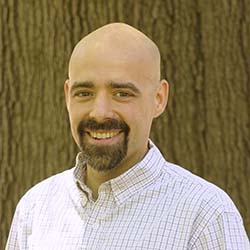Research on minerals in the ground may have big impacts for well placement in NC and beyond
“Minerals in the environment may exert even more control on the fate and transport of arsenic and other metals than previously thought,” Owen Duckworth, PhD, leader of the UNC SRP’s Project 4 explains.

Dr. Owen Duckworth
This is one of the key takeaways from recently published research on the structure of natural BIOS, or biogenic iron (oxyhydr)oxides, in groundwater in North Carolina. Researchers on the project worked to compare the structure of naturally occurring BIOS and the much more extensively studied synthetic mineral two-line ferrihydrite (2LFh).
Understanding these reactions can impact where wells are placed for residents of North Carolina and beyond.
Broadly speaking, UNC SRP’s Project 4 seeks to understand the fundamental chemical relationships between dissolved metals such as inorganic arsenic, and rocks and sediment in underground aquifers. These results serve to develop models to predict the vulnerability of groundwater to toxic metal contamination and inform future well placement to prevent exposure to this contamination.
The purpose for the recent comparison?
Duckworth explains, “In a 2017 study, we found that that iron minerals formed in the environment were better able to absorb arsenic than the synthetic minerals we usually use in the laboratory, but we were unable to explain why. This study illuminated key structural features of BIOS produced by bacteria.”
Further, according to Duckworth, “We showed that BIOS formed in natural waters may be more reactive than previously thought.”
The project involved using a diverse set of imaging techniques, such as X-ray absorption spectroscopy and high energy X-ray total scattering, as well as freezing and oven-drying to simulate wet-dry cycles occurring in the environment to compare the structures of naturally occurring BIOS and synthetic 2LFH. Results provided insight on the structural stability and possible persistence of BIOS in the groundwater environment.

Electron Microscopy image clearly showing structural differences of (A) 2LFh and (D) BIOS
Outcomes from this project suggest that BIOS are unique parts of environmental mineralogy, and that they have different structures and reactivities than 2LFh. This has implications for the ways researchers study how other materials, including contaminants, cycle and move through groundwater environments.
Duckworth adds, “we are also excited that the tools we used in this study may help us to collaborate with other projects such as Project 5 as they develop effective filters to remove arsenic from groundwater in private wells.”
